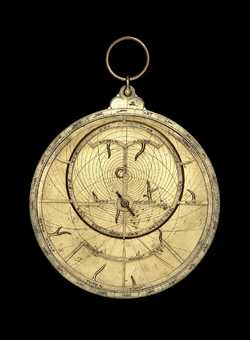| Date | late 14th or early 15th century |
| Place | Paris (?) |
| Material | Brass |
| Inventory no. | 54330 |
| Acquisition | Presented by J.A. Billmeir in 1957 |
This astrolabe carries two slight but intriguing inscriptions. On the throne is a small but deliberate mark which appears to incorporate the medieval numeral 4; but whether it is a number, a monogram, or a symbol of some other kind has not been discovered. If it were a maker's mark it would be a very early example - unlike the Islamic craftsmen, European makers rarely signed their work before the 16th century.
Secondly, the plate for latitude 49° has the inscription 'PIS' with a horizontal bar through the P. Such a bar usually indicates a suspension or abbreviation, so the most likely reading is Paris, for which the latitude is appropriate. The collector and historian Henri Michel, who owned the astrolabe before it came to the Museum (via the Billmeir Collection), read it differently, and extrapolated an imaginative provenance from it.
He read the P with bar as a monogram TP, and believed the astrolabe had been made by the French courtier and astrologer Thomas de Pisan (living about 1370) for his patron king Charles V, whose records show that he owned several astrolabes. It is an attractive theory, and bears witness to how the fascinating individuality of astrolabes can engage the imagination.
An alternative clue to the history of this instrument might be that along with seven whole-number latitude plates, including the 49° one for Paris (which is where the astrolabe was most probably made), there is one plate for the very specific latitude of 51° 40'. That would suggest an original owner in the Netherlands or Germany - or of course in Oxford.
View all
images for this astrolabe
View
detailed provenance for this astrolabe
Mater
The mater and limb are of two pieces, soldered construction. Scales on the limb: degree scale. More informationBack
The back contains 5 scales of the following types: Degree; Zodiacal signs; Calendar; Unequal hours; Shadow square. More informationRete, Pin & Wedge
The rete contains 17 stars. The zodiac on the rete is labelled: ARI , TAV , GEMI , CAN , LEO , VIR , LIB , SCOR , SAGI , CAP , AQW , PIS.The rete contains 1 scale of the following type: Ecliptic.
The rete is attached using a pin & wedge. More information



